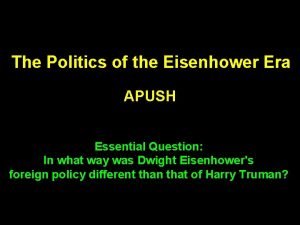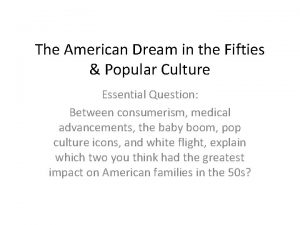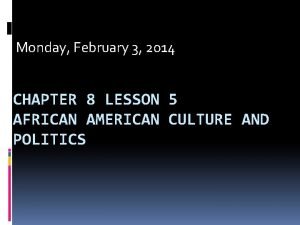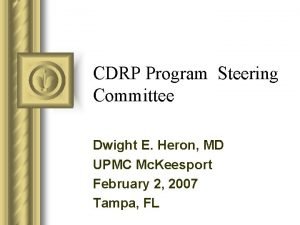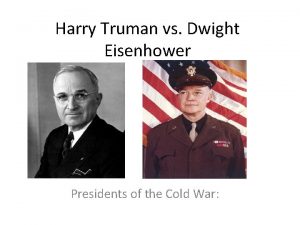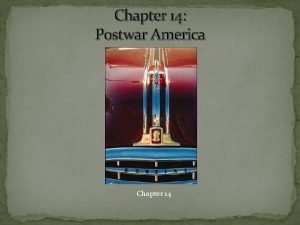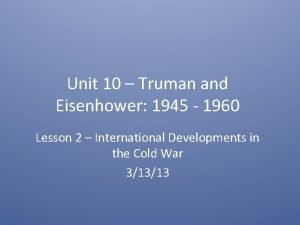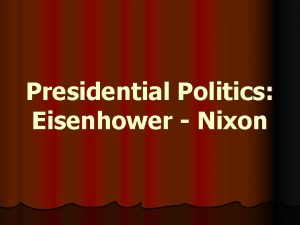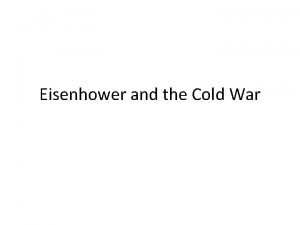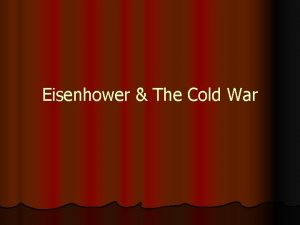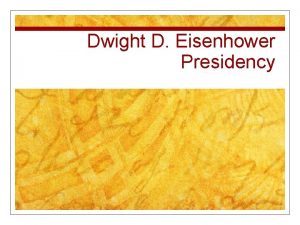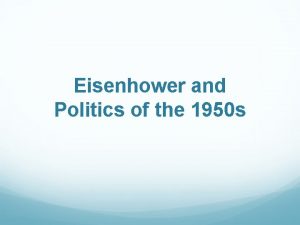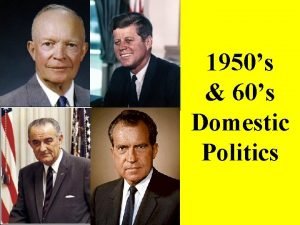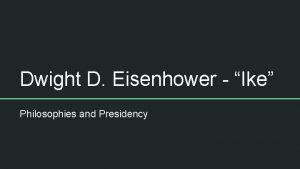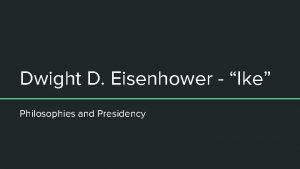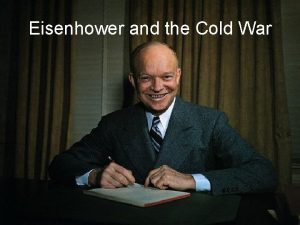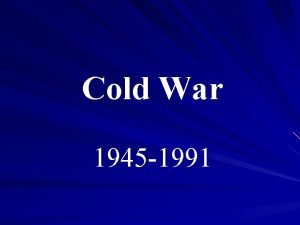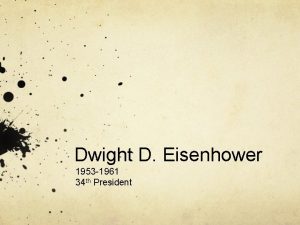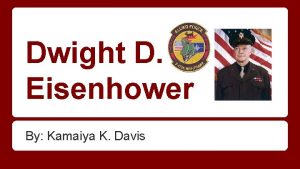The Fifties Politics and culture Dwight D Eisenhower














- Slides: 14

The Fifties Politics and culture

Dwight D. Eisenhower, 34 th President of the United States

The Hydrogen Bomb • A thermonuclear bomb which uses both fission and fusion. • Has the force of one million tons of TNT which is 67 times the power of the bomb dropped on Hiroshima, Japan. • The U. S. entered into a “race” with the Soviet Union to see who could produce the first H-Bomb. • U. S. tested its first H-Bomb on Nov. 1, 1952. • The Soviet Union tested its first HBomb in August 1953.

• Bikini Atoll was the site of 23 nuclear explosions. One being the test of the H-Bomb code named Castle Bravo. • It had the explosive force of 1000 Hiroshima-type bombs and left a crater in the lagoon floor that was a mile-wide. Vaporized 70 acres. • U. S. brought inhabitants back in 1968 but high levels of radiation were found to still exist. Residents then wanted the entire island deemed uninhabitable. • Bikinians are still receiving compensation from the U. S. for healthrelated issues.

John Foster Dulles • 52 nd U. S. Secretary of State • His father and his uncle had both served as Secretary of State earlier. • Anti-Communist, calling it “Godless terrorism. ” • Served in the military during World War II and achieved the rank of Major. • Served until his death in 1959. • Has an airport named for him in Virginia which is Washington, DC’s major hub.

Dulles International Airport

• Dulles recommends that the U. S. use all of its force against any aggressor nation. This included nuclear weapons if necessary. • Brinkmanship: The U. S. trimmed its Army and Navy while increasing its Air Force since it would drop the bombs. • President Eisenhower and Sec. Dulles were willing to go to the edge of all out war. • This development leads to the nuclear secrets being found by the Soviets and the development of their own nuclear weapons. The arms race had begun.


• Established in 1947 to take the place of the OSS (Office of Strategic Services) formed during World War II. • It provides national security intelligence and covert activities as directed by the president. • Over the years the CIA has helped overthrow foreign officials and has gotten involved in the affairs of foreign nations that are deemed a threat to the U. S. • The CIA has also been known to be responsible for the assassinations of some government officials from other countries. • In the early Fifties the U. S. got involved in the affairs of Iran. It had nationalized its own oil fields which had been privately held. The CIA wanted the deposed Shah of Iran to return. Eventually, with the CIA’s help the Shah returned and the oil fields were back in private hands.

Warsaw Pact Nations and NATO Countries

Geneva Summit, 1955

Suez Crisis • 1955: Great Britain and the U. S. agree to help Egypt build a dam on the Nile River called the Aswan Dam. • Gamel Abdel-Nasser , Egyptian leader tried to play the Soviets and the U. S. against each other. • Dulles then withdrew the U. S. offer of monetary aid • In response, Egypt nationalized the Canal which infuriated France and Great Britain that owned it. • Egypt refused to recognize the new nation of Israel and wouldn’t let Israeli ships through. • Israel, Great Britain and France send troops and seized the canal.

Eisenhower Doctrine: U. S. would defend the Middle East from any attack by a Communist nation. Congress approved this in 1957.

Hungarian Uprising • 1956: Hungarian people rose in revolt against Communist rule which was dominated by the Soviet Union. • Imre Nagy, a liberal Communist leader from Hungary, promised free elections, denounced the Warsaw Pact and demanded that Soviet Troops leave Hungary. • Soviet tanks rolled into Hungary and killed about 30, 000 people • The Hungarians fought back with pistols and bottles but were unable to put down the Soviet invasion. • 200, 000 people fled the country. Nagy was put to death. • The U. S. did nothing about this and the UN tried to pass several resolutions on the Security Council but to no avail since the Soviet Union vetoed each one.
 Eisenhower domestic policy
Eisenhower domestic policy Dwight d eisenhower accomplishments
Dwight d eisenhower accomplishments Eisenhower apush
Eisenhower apush Felix longoria
Felix longoria Chapter 8 lesson 5 african american culture and politics
Chapter 8 lesson 5 african american culture and politics Dwight heron
Dwight heron Ser name
Ser name Truman vs eisenhower
Truman vs eisenhower Lesson 1 truman and eisenhower
Lesson 1 truman and eisenhower Lesson 1 truman and eisenhower
Lesson 1 truman and eisenhower Example of material culture
Example of material culture Fed-batch
Fed-batch Difference between american culture and indian culture
Difference between american culture and indian culture Uses of selenite f broth
Uses of selenite f broth Folk culture and popular culture venn diagram
Folk culture and popular culture venn diagram


